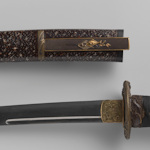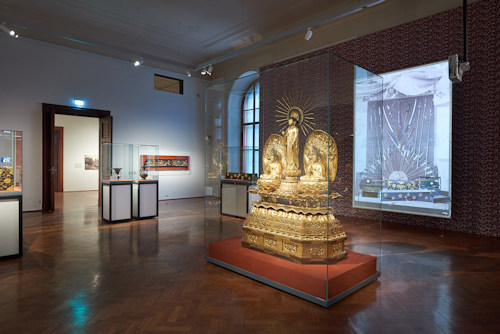
What does an eclectic mix of rare and not-so-rare items from Japan tell us about ourselves? Some answers perhaps come through the Meiji Era exhibition at the Weltmuseum.
- Exhibits drawn from those collected by Heinrich von Siebold in the early years of Japan’s opening to the outside from 1868
- Runs Feb 13 – Aug 11, 2020
- All display text in English, too
- See also:
- Current exhibitions in Vienna
The Heinrich von Siebold collection

(View of the exhibition; © KHM-Museumsverband)
Now, the Weltmuseum has a lot in common with buried treasure. You never know quite what you’ll find inside, but it’s likely to be something a little different, a little exotic.
The Japan in the Meiji Era exhibition combines the flair of undiscovered eastern climes with what feels like an exercise in subtlety.
On the surface, you have a small, mixed collection of items from Japan assembled by one Heinrich von Siebold (1852-1908).
Our German-born collector lived in Japan’s Meiji era (1868-1912) for much of his life, arriving there not long after the country opened up to foreigners. His interest in all things Japanese no doubt entered his blood via his father, a renowned Japan scholar of his day.
Von Siebold had a strong connection to Austria (or Austria-Hungary as it was at the time), too, working as an interpreter for the empire’s diplomatic mission in Tokyo and gifting many of his items to the Kaiser.
That gift has left Vienna’s Weltmuseum with quite a collection to draw on for this exhibition, which emerges from research work conducted together with the National Museum of Japanese History in Sakura.
The selection of items will not shock with bejeweled priceless majesty or exquisite artistry. Most are drawn from photos (which you can see) of how the collection appeared on display in 1883 in the home of von Siebold’s sister. And most are relatively unassuming.
The exhibits will, however, tease at your subconscious and raise two issues in your mind.
First, the banality of many items reminds us of our simple fascination with the new, the unknown and the undiscovered. Fishing poles and hairpins. Kettles and vases.
Second, the design and decoration highlights both our commonality across cultures (we’re all just trying to boil water), but also our differences (the animal motifs on a kettle bear no resemblance to those you might find in Europe, with subtle differences in the kettle’s form, too).
You have fans, but the shape, material (bamboo) and decoration differ entirely from the western-centric versions. The same might be said of an Edo period sword quiver…all wood, brass, mother of pearl, and lacquer.
Two shields exposed my ignorance – they were, in fact, hats. Such subtle lessons pervade the displays and perhaps echo some of the insights of the A Colonial Thing exhibition higher up the museum.
Not that there aren’t one or two exceptional delights to draw the eye. For example, the gilded bronze 19th-century incense burner in the shape of a pair of dragons. Or the large golden Amida Nyorai statue.
Dates, tickets & tips
The Japan exhibition runs from February 13 to August 11, 2020.
The grand news is that your normal entrance ticket to the Weltmuseum gives you access to all the special exhibitions inside, too. As does a Vienna Pass sightseeing pass (one-time only).
How to get to the Weltmuseum
Find your way to the museum entrance on Heldenplatz. Once inside, go into the main atrium on the ground floor and enter the rooms on the right for the Japan exhibition.
That atrium looks pretty spectacular, and we often pop in for a coffee there, since you only need a ticket to go into the actual exhibition rooms.
Address: Heldenplatz, 1010 Vienna